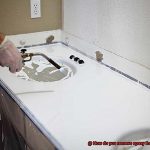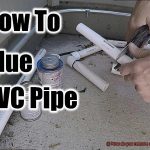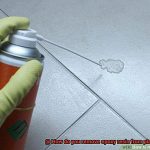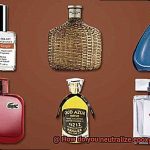Are you a DIY enthusiast who loves to experiment with epoxy glue? Do you find the aroma of fresh epoxy invigorating? If so, then you’ve probably encountered the sticky situation of dealing with dried epoxy glue. It’s a nuisance to work with, and it has a habit of smudging and clinging onto everything in its path.
Whether it’s an accidental spill on your favorite shirt or a stubborn blob of glue on some other surface, removing dried epoxy can be quite the challenge. But don’t worry; we’ve got your back.
In this blog post, we’ll explore some of the most effective and straightforward ways to remove dried epoxy glue. From using heat and solvents to specialized epoxy removers, we’ll guide you through each step so that you can choose the method that best suits your needs. We’ll also provide safety precautions and valuable tips to ensure that you can remove dried epoxy without damaging the surface or putting yourself at risk.
So grab yourself a cup of coffee, sit back, and get ready to learn everything you need to know about removing dried epoxy glue like a pro.
What is Dried Epoxy Glue?
Contents
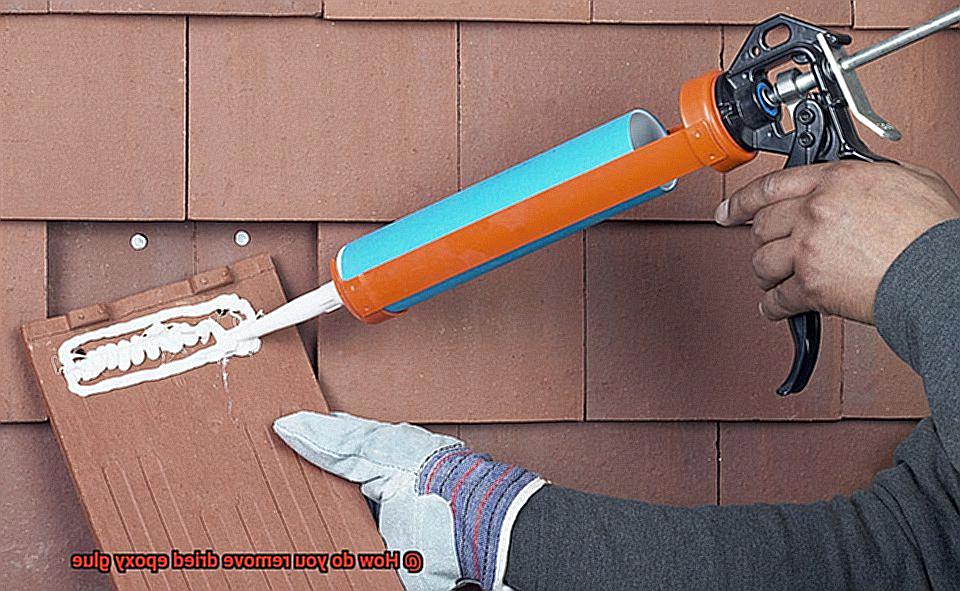
Dried epoxy glue is a powerful adhesive made up of two components: a resin and a hardener. When combined, they trigger a chemical reaction, resulting in a tight bond between two surfaces. This versatile adhesive is commonly used across various industries, including DIY projects, construction, and manufacturing, due to its incredible durability and strength.
However, once it dries, epoxy glue becomes stubbornly rigid and challenging to remove. It can cling to surfaces like wood, metal, plastic, and even skin, making it a tricky task to remove without causing damage.
Removing dried epoxy glue requires specialized techniques and tools. There are different types of epoxy glues available in the market; some are designed for specific industries and applications while others are suitable for general use. Therefore, it’s essential to understand the type of epoxy glue used before attempting to remove it.
Several methods can be used to remove dried epoxy glue. One of the most effective ways is by using a heat gun or hair dryer to soften the glue. This method makes it easier to scrape off with a putty knife or scraper tool. However, caution should be taken when using heat as it can damage surfaces and potentially cause injury.
Another method is by using solvents such as acetone or rubbing alcohol. These substances dissolve the epoxy glue, making it easy to wipe or scrape away. It’s important to note that these chemicals can be hazardous and should be used in a well-ventilated area while wearing proper safety gear.
Mechanical methods such as sanding or grinding can also be used to remove dried epoxy glue. However, this method works best on flat surfaces as achieving a smooth finish on curved or uneven surfaces can be challenging.
Lastly, there are commercial epoxy removers readily available in the market that are specifically designed for removing dried epoxy glue. These products typically contain strong chemicals and should be used with caution while following the manufacturer’s instructions.
Heat Gun/Hair Dryer Method
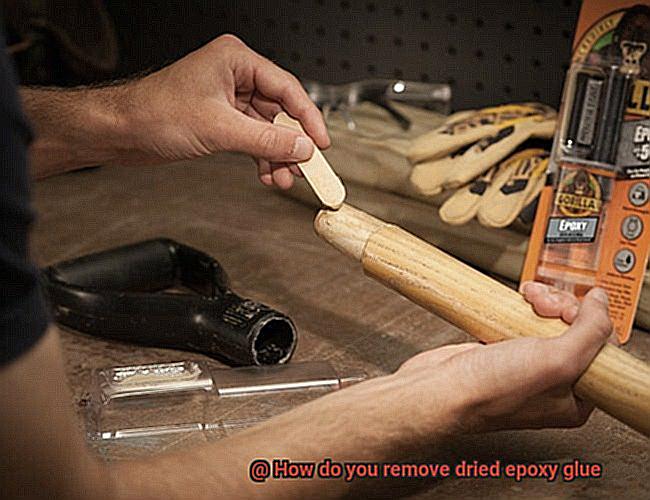
Look no further than the heat gun/hair dryer method, a popular and effective solution to this pesky problem.
To get started, gather your tools: a heat gun or hair dryer, a scraper or putty knife, and gloves. With these items at the ready, let’s dive into the step-by-step process of using the heat gun/hair dryer method.
First, turn on your heat source and set it to the highest setting. Hold it about 2-3 inches away from the surface and move it continuously over the stubborn epoxy glue. Keep in mind not to hold it too close as this can potentially damage the material.
As you apply heat to the glue, you’ll notice it begin to soften and become more pliable. Once it reaches this point, use your scraper or putty knife to gently scrape away the softened epoxy glue. Ensure that you’re wearing gloves as the glue can be hot and sticky.
If there are any remaining bits of epoxy glue that won’t budge, repeat the heating process until it becomes pliable enough to scrape off. Patience is key here, so take your time and be gentle to avoid scratching or damaging the surface.
Once all of the epoxy glue has been removed, clean the surface with a mild cleaner and cloth. Admire your handiwork and enjoy your newly restored surface.
It’s important to note that while this method works wonders on hard surfaces like metal, wood, and plastic, it may not be suitable for more delicate materials such as fabric or paper. In these cases, alternative methods such as using solvents or sanding may be a better option.
Solvent Method
The solvent method is here to save the day. As an expert in this field, I can confidently say that solvents are a fantastic option for removing stubborn dried epoxy glue.
It’s important to note that different types of epoxy glue require different solvents. Acetone is the most popular and effective solvent for removing dried epoxy glue, but rubbing alcohol, vinegar, mineral spirits, and even vegetable oil can also work. However, keep in mind that these alternatives may not be as effective and may require more effort to remove the glue.
Now let’s dive into how to use a solvent to remove dried epoxy glue. If you’re using acetone or rubbing alcohol, simply soak a cloth or cotton ball in the solvent and apply it directly to the dried glue. Let it sit for a few minutes, then use a scraper or plastic spatula to gently scrape away the glue. Remember to wear gloves and work in a well-ventilated area when using these strong chemicals.
If you’re using an alternative solvent like vinegar or mineral spirits, the process is similar. Soak a cloth or cotton ball in the solvent and apply it to the dried glue. Let it sit for a few minutes, then use a scraper or plastic spatula to gently scrape away the glue. However, keep in mind that these solvents may not be as effective and may require more elbow grease to remove the glue.
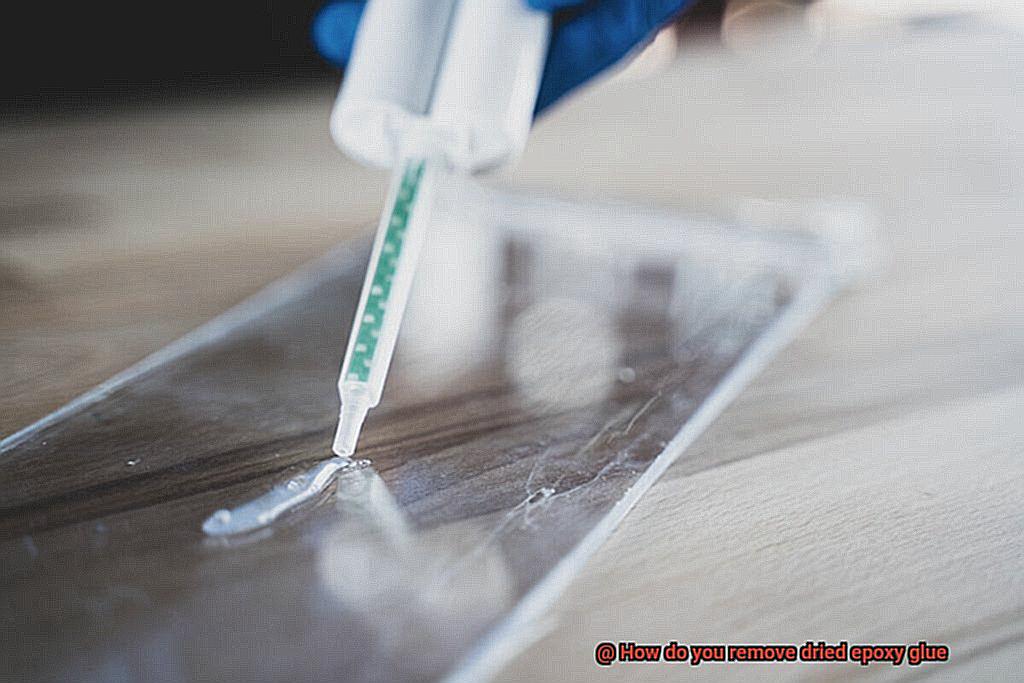
Before using any solvent on a surface, always test it on a small, hidden area first to make sure it doesn’t damage or discolor the surface. Additionally, always take safety precautions when working with strong chemicals by wearing gloves and working in a well-ventilated area.
Mechanical Method
This method involves physically scraping or sanding off the glue, making it ideal for surfaces that can handle abrasion without damage.
To begin this process, you will need a scraper and sandpaper. The sandpaper grit you need will depend on the type of surface you’re working with. You’re now ready to get started.
Firstly, use the scraper to gently remove as much of the glue as possible. Be careful not to scrape too hard, or you may cause damage or scratches to the underlying surface. This part requires patience and attention to detail.
After scraping off as much glue as possible, it’s time to switch to sandpaper. Begin with coarse-grit sandpaper and work your way up to finer grits until you achieve a smooth, clean surface. Use a gentle circular motion when sanding to avoid creating scratches or other damage.
While effective, it’s essential to note that the mechanical method can be labor-intensive and time-consuming, particularly for larger surfaces. Furthermore, it may not be suitable for delicate or intricate surfaces that could easily get damaged by abrasive action.
Commercial Epoxy Removers
If you’ve ever worked with epoxy glue, you know how difficult it can be to remove once it has dried. That’s where commercial epoxy removers come in – powerful products specifically designed to dissolve and remove cured epoxy from surfaces. As an expert in this field, I’ve compiled some important information to help you understand and use these products safely and effectively.
First and foremost, it’s crucial to understand the potential dangers associated with commercial epoxy removers. These products often contain harsh chemicals that can cause skin irritation and respiratory issues if not used properly. Always read the product label carefully and follow all safety precautions listed, including wearing protective gloves, eyewear, and a respirator if necessary.
To use a commercial epoxy remover, start by applying the product evenly over the cured epoxy. Allow it to penetrate for the recommended amount of time (typically 15-30 minutes) before attempting to remove the epoxy. You can scrape it away with a plastic scraper or wipe it clean with a cloth. It’s important to note that some commercial epoxy removers may require multiple applications to fully dissolve the cured epoxy.
When choosing a commercial epoxy remover, look for products containing ingredients such as acetone, methylene chloride, or N-methylpyrrolidone. These are common chemicals found in effective epoxy removers that break down the molecular bonds of cured epoxy, making it easier to remove.
If you’re wondering whether or not commercial epoxy removers are worth the investment, consider how much time and effort you’ll save by using them. Instead of spending hours scraping and sanding away at dried epoxy glue, you can simply apply a commercial remover and watch the epoxy dissolve before your eyes.
Safety Precautions to Consider
If you’re planning to remove dried epoxy glue from a surface, it’s paramount that you consider the safety precautions involved. Epoxy glue is a strong adhesive that requires tough chemicals and tools to remove, which can be hazardous if not handled properly. To ensure your safety and the safety of those around you, here are some safety measures to take into consideration:
Firstly, make sure you have the right protective gear. Gloves, goggles, and a mask are essential when handling removal chemicals. Gloves will protect your hands from the chemicals used in the removal process, while goggles will shield your eyes from any splashes or fumes. A mask will prevent you from inhaling any harmful fumes that may be released during the process.
Secondly, proper ventilation is key. The chemicals used in removal can release harmful fumes into the air, which can be dangerous if inhaled in large quantities. Ensure that the area where the removal process is taking place is well-ventilated by opening windows or using a fan to circulate fresh air.
Thirdly, it’s important to read and follow instructions on the chemical products being used for epoxy glue removal. Different chemicals have different instructions and must be used in specific ways. Failure to follow these instructions could result in injury or damage to property.
Moreover, it’s recommended that you use appropriate equipment for the job such as a scraper or a heat gun. Avoid using sharp objects that may cause injuries and always handle equipment with care.
Lastly, disposal of waste materials should be done safely and responsibly. Used chemicals, rags, and other materials used during the removal process can be hazardous and should not be disposed of in regular trash cans. Instead, they should be disposed of in accordance with local regulations and guidelines.
Tips for Removing Dried Epoxy Glue
Removing dried epoxy glue can be a daunting task, but with the right tools and techniques, it can be done easily. Here are five effective methods for removing dried epoxy glue:
Heat
Using heat is an efficient way to remove dried epoxy glue. You can use a heat gun or a hair dryer to soften the glue, making it easier to scrape off with a scraper or putty knife. However, take care to wear gloves and eye protection as the heat can cause fumes that are harmful if inhaled.
Solvents
Solvents such as acetone, alcohol, or vinegar can also dissolve the glue and make it easier to wipe away with a cloth or paper towel. Before applying the solvent, test it on an inconspicuous area first to ensure that it doesn’t damage the surface.
Sanding
Sanding can be useful if the glue is too hard to remove with heat or solvents. Use fine-grit sandpaper and work slowly and carefully to avoid damaging the surface.
Chemical strippers
Chemical strippers contain chemicals that dissolve the glue, making it easier to remove. However, these products can be harsh and should be used with caution.
Razor blade
A razor blade can also be used to remove dried epoxy glue. Hold the razor blade at an angle and carefully scrape away the glue, being careful not to scratch or damage the surface underneath.
Remember that prevention is always better than cure when it comes to removing dried epoxy glue. Take precautions such as wearing gloves and using protective coverings or barriers when working with epoxy glue to avoid spilling it on surfaces in the first place.
Alternatives to Removal of Dried Epoxy Glue
It can be a real headache, but fear not, there are several alternatives to removal that you may not have considered before.
Firstly, heat is a common method for softening the glue and making it easier to remove. You can use a heat gun or hair dryer on high heat, but be cautious not to overheat the area and cause damage.
Chemicals are another effective alternative. Acetone, vinegar, and rubbing alcohol can all dissolve epoxy glue. However, make sure to follow instructions carefully and wear protective gloves when using chemicals.
If you’re willing to put in some elbow grease, sanding is another option. Use coarse-grit sandpaper to sand down the glue until it’s level with the surrounding surface. Although this method may take longer than others, it’s highly effective.
Lastly, if all else fails, mechanical removal is an option. This involves using a scraper or chisel to physically remove the dried epoxy glue. However, be cautious as this method may cause damage to the surface underneath.
Remember, not every alternative will work for every situation. It’s best to try one method at a time and see which one works best for your specific situation. Always wear protective gear and work in a well-ventilated area when using these methods.
Conclusion
In conclusion, removing dried epoxy glue can be a daunting task, but fear not. With the right techniques and tools, it can be done safely and effectively. There are various methods to choose from, including heat and solvents, specialized epoxy removers, and mechanical means. However, before attempting any removal method, it’s crucial to know the type of epoxy glue used.
Safety should always come first when working with chemicals. Protective gear such as gloves and proper ventilation are essential when using chemical products. It’s also important to follow instructions on chemical products carefully and use appropriate equipment. Remember to dispose of waste materials responsibly.
Prevention is key when it comes to dealing with dried epoxy glue. Take precautions by wearing protective coverings or barriers when working with epoxy glue to avoid spilling it on surfaces in the first place.
If removal is not an option or proves too difficult, alternatives such as heat, chemicals, sanding or mechanical removal can also be effective. Try one method at a time and see which works best for your specific situation.


